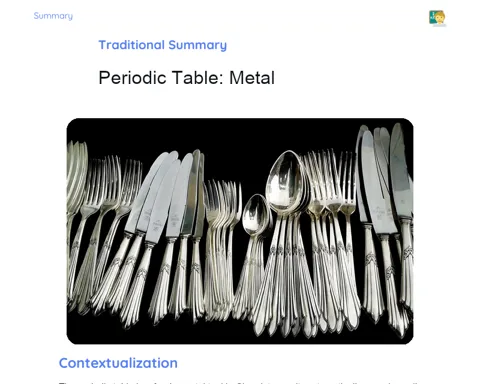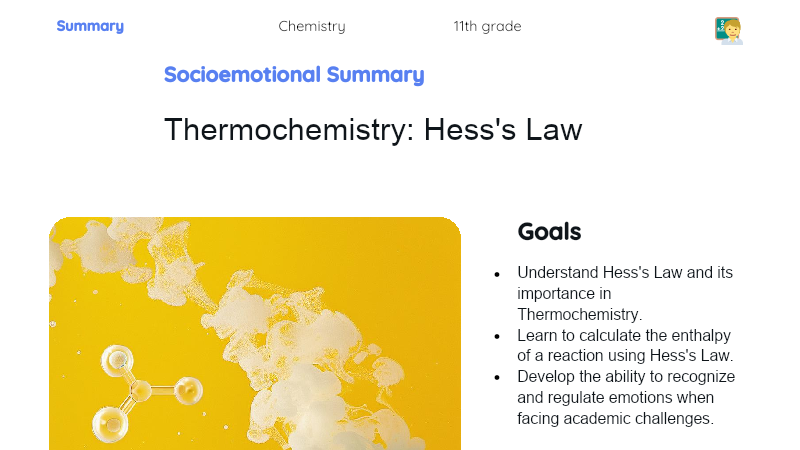Solutions: Introduction | Active Summary
Objectives
1. Identify and differentiate the components of a solution: solute and solvent.
2. Understand and explain why a solution is considered a homogeneous mixture.
3. Develop analytical skills to classify mixtures based on the characteristics of homogeneous solutions.
Contextualization
Did you know that the soda you love is a solution? Yes! When you open a bottle of soda, you are releasing the carbon dioxide that was dissolved in the water, forming a solution. This solution is not only delicious but also perfectly exemplifies the concept of solution in chemistry, where carbon dioxide is the solute and water is the solvent. Understanding solutions is not just about laboratory experiments, but also about understanding the processes that occur in everyday products.
Important Topics
Solutes
Solutes are substances that are dissolved in a solvent to form a solution. They can be solids, liquids, or gases. The amount of solute that can be dissolved in a solvent depends on the nature of the solute and solvent, as well as the conditions of temperature and pressure.
-
The type of solute can directly affect its solubility in a solvent. For example, polar solutes tend to dissolve better in polar solvents, while nonpolar solutes dissolve better in nonpolar solvents.
-
The solubility of a solute in a solvent can be increased with a rise in temperature, as this usually increases the kinetic energy of the molecules, allowing for more interactions between solutes and solvents.
-
The maximum amount of solute that can be dissolved in a specific amount of solvent at a given temperature is known as solubility. A solution in which no additional amount of solute can be dissolved at that temperature is called saturated.
Solvents
Solvents are substances that dissolve solutes, forming a solution. Water is one of the most common and versatile solvents, known as the 'universal solvent' due to its ability to dissolve a wide variety of substances.
-
The type of solvent can influence the dissolving capacity of different solutes. For example, water, as a polar solvent, will dissolve polar solutes better than nonpolar solutes.
-
Solvents can be classified as polar and nonpolar, and the choice of solvent is crucial in forming a stable and effective solution, depending on the nature of the solute and the desired application.
-
Toxicity, flammability, and other properties of solvents must be considered when choosing a solvent for a specific application, such as cleaning products or industrial processes.
Solutions
A solution is a homogeneous mixture of two or more substances, where the solute is completely dispersed in the solvent. The homogeneity of solutions is a fundamental characteristic that distinguishes them from other mixtures, such as suspensions or colloids.
-
The homogeneity of solutions allows them to be used in a wide range of applications, from medicine to industrial chemistry, where the uniformity of the mixture is essential.
-
The process of forming a solution involves the interaction between the molecules of the solute and the solvent, leading to the formation of a thermodynamically more stable system.
-
The concentration of a solution, which refers to the amount of solute dissolved in a given volume of solvent, is crucial for many practical applications, such as in medicine and industry.
Key Terms
-
Solution: A homogeneous mixture of two or more substances, where one component (solute) is evenly dispersed in another (solvent).
-
Solute: The substance that is dissolved in a solvent to form a solution.
-
Solvent: The substance that dissolves the solute to form the solution. Usually, the solvent is the component in larger quantity in a solution.
To Reflect
-
How do you think the choice of solvent can influence the effectiveness of a medication?
-
In what ways does a saturated solution differ from an unsaturated solution and how is that important in industrial processes?
-
What is the importance of solutions in environmental preservation and sustainability?
Important Conclusions
-
We reviewed the concept of solutions as homogeneous mixtures of solutes in solvents, highlighting how the type of solute and solvent affect the formation and stability of solutions.
-
We discussed the importance of solutions in everyday life, from cooking to industry, and how understanding these chemical mixtures is essential in various professions and practical applications.
-
We explored solubility as a property that varies with the nature of solutes and solvents, and how factors such as temperature and pressure influence the dissolving capacity.
To Exercise Knowledge
Create a solutions diary: For one week, note all the solutions you find at home or school. Identify the solutes and solvents of each and try to explain why they were chosen for that specific application. Discuss your observations with a colleague or family member.
Challenge
Chemical Chef Challenge: Choose a dish you enjoy cooking and explain the chemical reactions that occur when mixing the ingredients, highlighting the solutions formed. Try replacing one of the ingredients with an alternative that forms a different solution and observe how it affects the flavor or final texture of the dish.
Study Tips
-
Visualize! Use graphics or videos to see how solute and solvent molecules interact to form a solution. This can help better understand the concept of solubility and miscibility.
-
Experiment at home! Conduct small solubility experiments with safe and common materials, like sugar and salt in water, to see the theory in action.
-
Make mind maps! Create conceptual maps that connect solutions with other areas of chemistry and practical applications, such as in medicine or food industry, to help memorize and better understand the content.



